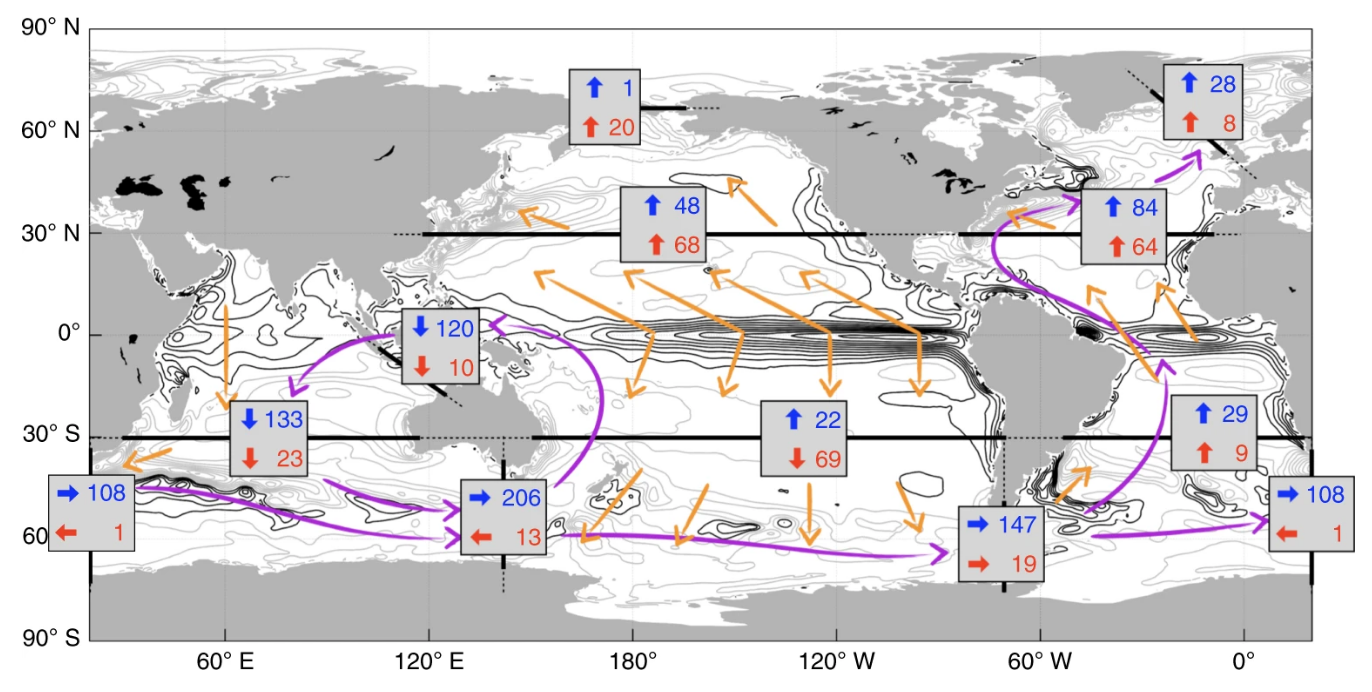
Researchers in the US and the UK have been analyzing ocean heat transport in a recent ECCO dataset to investigate how it varies globally. The widely used ECCO estimates combine the MITgcm with diverse observations to produce a quantitative depiction of the time-evolving global ocean state.
Reporting by Helen Hill for MITgcm

Researchers in the US and the UK have been analyzing ocean heat transport in a recent ECCO dataset to investigate how it varies globally.

Gael Forget, is a Physical Oceanographer with broad interests in ocean circulation and climate variability including global transports, turbulence statistics, and inverse modeling as well as the interaction of ecology, geochemistry, and physical processes. When he’s not tackling ocean data and models, in his spare time he enjoys cycling, playing tennis, and traveling. He has been a user of MITgcm and its adjoint since 2002.
A key mechanism by which the oceans regulate Earth’s climate is through the redistribution of thermal energy. In a new study published this month in Nature Geoscience Gaël Forget, a research scientist at MIT, and David Ferreira, an Associate Professor at Reading University in the UK analyzed ocean heat transport in the ECCO version 4 (release 2) ocean state estimate and developed a new method to separate it into an ‘effective’ ocean heat transport, which reflects air-sea heat fluxes, and internal ocean heat loops which have obscured the interpretation of measurements in previous studies.

David Ferreira studies the dynamics of oceans and how they regulate Earth’s climate. A principal interest is the dynamics of ocean eddies and how to represent their effects in climate models. According to the MITgcm archivist Ferreira has also been using MITgcm since 2002 and a favorite pass-time is watching Rugby
“Analyses of ocean heat transport tend to emphasize global-scale seawater pathways however, it is actually the divergence or convergence of heat transport within a given region, rather than the origin or destination of seawater transiting through that region, that is most immediately relevant to Earth’s heat budget,” says Forget.
The pair’s analysis demonstrates the overwhelming predominance of the tropical Pacific which is found to export four times as much heat as is imported in the Atlantic and Arctic.
“A key outcome of our study is that inter-basin heat exchanges (through for example The Drake Passage, or the Indonesian archipelago) play a relatively minor role in the global heat balance perhaps suggesting that global-scale seawater pathways play only a minor role in Earth’s heat budget,” says Ferreira.
Forget and Ferreira note that their work also highlights the unique ability of the Atlantic to transport heat Northward across the equator, and the Indian ocean to transport heat Southward.
To find out more about this work email gforget@mit.edu or d.g.ferreira@reading.ac.uk
This Month’s Featured Publication
- Forget, G. and D. Ferreira (2019), Global ocean heat transport dominated by heat export from the tropical Pacific, Nature Geoscience, doi: 10.1038/s41561-019-0333-7
Other New Publications this Month
Khider J. Al-Jaburi (2019), Passive Flow Control of Rotary-wing and Fixed-wing Aircraft Airfoils via Surface-based Trapped Vortex Generators, Doctoral Dissertation in Aerospace Engineering, Ottawa-Carleton Institute for Mechanical & Aerospace Engineering, Department of Mechanical & Aerospace Engineering, Carleton University
Ottawa, Ontario, Canada
Irene Nadal Arizo (2019), Tidal dynamics effect on the connectivity patterns of the blackspot seabream (Pagellus bogaraveo) in the Alboran Sea, Doctoral Dissertation Universitat Politecnica de Vallencia
Scott D. Bachman (2019), The GM+E closure: A framework for coupling backscatter with the Gent and McWilliams parameterization, Ocean Modelling, doi: 10.1016/j.ocemod.2019.02.006
T. V. Belonenko, D. L. Volkov, A. V. Koldunov (2018), Shelf Waves in the Beaufort Sea in a High-Resolution Ocean Model, A.V. Oceanology, doi: 10.1134/S0001437018060024
Carton, J., S. Penny, and E. Kalnay (2019), Temperature and salinity variability in soda3, ECCO4r3, and ORAS5 ocean reanalyses, 1993-2015, Journal of Climate, doi: 10.1175/JCLI-D-18-0605.1
Baylor Fox-Kemper et al (2019), Challenges and Prospects in Ocean Circulation Models, Front. Mar. Sci., doi: 10.3389/fmars.2019.00065
Patrick Heimbach, Ichiro Fukumori, Christopher N. Hill, Rui M. Ponte, Detlef Stammer, Carl Wunsch, Jean-Michel Campin, Bruce Cornuelle, Ian Fenty, Gaël Forget, Armin Köhl, Matthew Mazloff, Dimitris Menemenlis, An T. Nguyen, Christopher Piecuch, David Trossman, Ariane Verdy, Ou Wang and Hong Zhang (2019), Putting It All Together: Adding Value to the Global Ocean and Climate Observing Systems With Complete Self-Consistent Ocean State and Parameter Estimates, Frontiers of Marine Science, doi: 10.3389/fmars.2019.00055
Kenneth G. Hughes and Jody M. Klymak (2019), Tidal conversion and dissipation at steep topography in a channel poleward of the critical latitude, Journal of Physical Oceanography, doi: 10.1175/JPO-D-18-0132.1
Li, Q., X. Mao, J. Huthnance, S. Cai, and S. Kelly (2019), On Internal Waves Propagating Across a Geostrophic Front, J. Phys. Oceanogr., doi: 10.1175/JPO-D-18-0056.1
Patrick Marsaleix, Héloïse Michaud, Claude Estournel (2019), 3D phase-resolved wave modeling with a non-hydrostatic ocean circulation model, Ocean Modeling, doi: 10.1016/j.ocemod.2019.02.002
Xunwei Nie, Shan Gao, Fan Wang, Jianwei Chi, Tangdong Qu (2019), Origins and pathways of the Pacific Equatorial Undercurrent identified by a simulated adjoint tracer, JGR Oceans, doi: 10.1029/2018JC014212
Sergey Prants, Gregory Reznik, Jacques Verron (2019), The international conference “Vortices and coherent structures: from ocean to microfluids”, Vladivostok, Russia, 28–31 August 2017, Journal of Ocean Dynamics, doi: 10.1007/s10236-019-01257-3
Shengmu Yang, Jiuxing Xing, Jinyu Sheng, Shengli Chen, Daoyi Chen (2019), A process study of interactions between a warm eddy and the Kuroshio Current in Luzon Strait: The fate of eddies, Journal of Marine Systems, doi: 10.1016/j.jmarsys.2019.02.009
Kaushik Srinivasan, James C. McWilliams, M. Jeroen Molemaker, and Roy Barkan (2019), Submesoscale Vortical Wakes in the Lee of Topography, Journal of Physical Oceanography, doi: 10.1175/JPO-D-18-0042.1
Jinbo Wang and Lee-Lueng Fu (2019), On the Long-wavelength Validation of the SWOT KaRIn Measurement, Journal of Atmospheric and Oceanic Technology, doi: 10.1175/JTECH-D-18-0148.1
Behnam Zamani, Thomas Krumpen, Lars H. Smedsrud, Rüdiger Gerdes (2019), Fram Strait sea ice export affected by thinning: comparing high-resolution simulations and observations, Climate Dynamics, doi: 10.1007/s00382-019-04699-z
Y. Zhang and Y. P. Guan (2019), Striations in Marginal Seas and the Mediterranean Sea, Geophysical Research Letters, doi: 10.1029/2018GL081050
Zhiyuan Li and Daji Huang (2019), Sea Surface Height and Current Responses to Synoptic Winter Wind in the Bohai, Yellow, and East China Seas: Two Leading Coastal Trapped Waves, Journal of Geophysical Research – Oceans, doi: 10.1029/2018JC014120
Do you have news about research using MITgcm? We are looking for contributions to these pages. If you have an interesting MITgcm project (ocean, atmosphere, sea-ice, physics, biology or otherwise) that you want to tell people about, get in touch. To make a post, contact Helen
